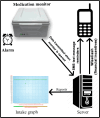Digital Adherence Technologies Linked to Mobile Money Incentives for Medication Adherence Among People Living With Tuberculosis: Mixed Methods Feasibility and Acceptability Study
- PMID: 38819905
- PMCID: PMC11179015
- DOI: 10.2196/47996
Digital Adherence Technologies Linked to Mobile Money Incentives for Medication Adherence Among People Living With Tuberculosis: Mixed Methods Feasibility and Acceptability Study
Abstract
Background: Complementing digital adherence technologies (DATs) with mobile money incentives may improve their utility in supporting tuberculosis medication adherence, yet the feasibility and acceptability of this integrated approach remain unclear.
Objective: This study aims to describe the feasibility and acceptability of a novel DAT intervention called My Mobile Wallet composed of real-time adherence monitoring, SMS text message reminders, and mobile money incentives for tuberculosis medication adherence in a low-income setting.
Methods: We purposively recruited people living with tuberculosis from the Mbarara Regional Referral Hospital in Mbarara, Uganda, who (1) were starting tuberculosis treatment at enrollment or within the past 4 weeks, (2) owned a mobile phone, (3) were able to use SMS test messaging, (4) were aged ≥18 years, and (5) were living in Mbarara district. At study exit (month 6), we used interviews and questionnaires informed by the unified theory of acceptance and use of technology (UTAUT) to collect feasibility and acceptability data, reflecting patients' experiences of using each component of My Mobile Wallet. Feasibility also included tracking the functionality of the adherence monitor (ie, an electronic pillbox) as well as SMS text message and mobile money delivery. We used a content analytical approach to inductively analyze qualitative data and Stata (version 13; StataCorp LLC) to analyze quantitative data.
Results: All 39 participants reported that the intervention was feasible because it was easy for them to use (eg, access and read SMS text messages) and worked as expected. Almost all SMS text messages (6880/7064, 97.4%) were sent as planned. The transmission of adherence data from the monitor worked well, with 98.37% (5682/5776) of the data transmitted as planned. All participants additionally reported that the intervention was acceptable because it helped them take their tuberculosis medication as prescribed; the mobile money incentives relieved them of tuberculosis-related financial burdens; SMS text message reminders and electronic pillbox-based alarms reminded them to take their medication on time; and participants perceived real-time adherence monitoring as "being watched" while taking their medication, which encouraged them to take their medication on time to demonstrate their commitment. The intervention was perceived as a sign of care, which eventually created emotional support and a sense of connectedness to health care. Participants preferred daily SMS text message reminders (32/39, 82%) to reminders linked to missed doses (7/39, 18%), citing the fact that tuberculosis medication is taken daily.
Conclusions: The use of real-time adherence monitoring linked to SMS text message reminders and mobile money incentives for tuberculosis medication adherence was feasible and acceptable in a low-resource setting where poverty-based structural barriers heavily constrain tuberculosis treatment and care.
Trial registration: ClinicalTrials.gov NCT05656287.
Keywords: SMS text message reminders; digital adherence technologies; financial incentives; medication adherence; mobile money; real-time monitoring; tuberculosis; user-centered approach.
©Angella Musiimenta, Wilson Tumuhimbise, Esther Atukunda, Aaron Mugaba, Sebastian Linnemayr, Jessica Haberer. Originally published in JMIR Human Factors (https://humanfactors.jmir.org), 31.05.2024.
Conflict of interest statement
Conflicts of Interest: None declared.
Figures
Similar articles
-
Engagement With Digital Adherence Technologies as Measures of Intervention Fidelity Among Adults With Drug-Susceptible Tuberculosis and Health Care Providers: Descriptive Analysis Using Data From Cluster-Randomized Trials in Five Countries.JMIR Public Health Surveill. 2025 Jul 28;11:e62881. doi: 10.2196/62881. JMIR Public Health Surveill. 2025. PMID: 40720892 Free PMC article.
-
Mobile phone text messaging for medication adherence in secondary prevention of cardiovascular disease.Cochrane Database Syst Rev. 2024 Mar 27;3(3):CD011851. doi: 10.1002/14651858.CD011851.pub3. Cochrane Database Syst Rev. 2024. PMID: 38533994 Free PMC article.
-
Mobile phone messaging for facilitating self-management of long-term illnesses.Cochrane Database Syst Rev. 2012 Dec 12;12(12):CD007459. doi: 10.1002/14651858.CD007459.pub2. Cochrane Database Syst Rev. 2012. PMID: 23235644 Free PMC article.
-
Mobile phone text messaging to improve medication adherence in secondary prevention of cardiovascular disease.Cochrane Database Syst Rev. 2017 Apr 29;4(4):CD011851. doi: 10.1002/14651858.CD011851.pub2. Cochrane Database Syst Rev. 2017. Update in: Cochrane Database Syst Rev. 2024 Mar 27;3:CD011851. doi: 10.1002/14651858.CD011851.pub3. PMID: 28455948 Free PMC article. Updated.
-
Mobile phone messaging reminders for attendance at healthcare appointments.Cochrane Database Syst Rev. 2013 Dec 5;2013(12):CD007458. doi: 10.1002/14651858.CD007458.pub3. Cochrane Database Syst Rev. 2013. PMID: 24310741 Free PMC article.
Cited by
-
A survey on medication adherence and influencing factors among 226 peritoneal dialysis patients in a primary hospital in China.BMC Nephrol. 2025 Jan 2;26(1):3. doi: 10.1186/s12882-024-03911-5. BMC Nephrol. 2025. PMID: 39748292 Free PMC article.
References
-
- Yoeli E, Rathauser J, Rand D. The resurgence of tuberculosis is behavioral, not medical. Nudges can fix it. STAT. [2024-03-03]. https://www.statnews.com/2019/10/25/tuberculosis-behavior-text-based-nud...
-
- Boutilier JJ, Yoeli E, Rathauser J, Owiti P, Subbaraman R, Jónasson JO. Can digital adherence technologies reduce inequity in tuberculosis treatment success? Evidence from a randomised controlled trial. BMJ Glob Health. 2022 Dec 01;7(12):e010512. doi: 10.1136/bmjgh-2022-010512. https://gh.bmj.com/lookup/pmidlookup?view=long&pmid=36455988 bmjgh-2022-010512 - DOI - PMC - PubMed
-
- Rao JS, Diwan V, Kumar AA, Varghese SS, Sharma U, Purohit M, Das A, Rodrigues R. Acceptability of video observed treatment vs. directly observed treatment for tuberculosis: a comparative analysis between south and central India. Wellcome Open Res. 2022 May 13;7:152. doi: 10.12688/wellcomeopenres.17865.1. - DOI
-
- Musiimenta A, Tumuhimbise W, Mugaba AT, Muzoora C, Armstrong-Hough M, Bangsberg D, Davis JL, Haberer JE. Digital monitoring technologies could enhance tuberculosis medication adherence in Uganda: mixed methods study. J Clin Tuberc Other Mycobact Dis. 2019 Dec;17:100119. doi: 10.1016/j.jctube.2019.100119. https://linkinghub.elsevier.com/retrieve/pii/S2405-5794(19)30019-1 S2405-5794(19)30019-1 - DOI - PMC - PubMed
-
- Barter DM, Agboola SO, Murray MB, Bärnighausen T. Tuberculosis and poverty: the contribution of patient costs in sub-Saharan Africa--a systematic review. BMC Public Health. 2012 Nov 14;12(1):980. doi: 10.1186/1471-2458-12-980. https://bmcpublichealth.biomedcentral.com/articles/10.1186/1471-2458-12-980 1471-2458-12-980 - DOI - DOI - PMC - PubMed
Publication types
MeSH terms
Substances
Associated data
Grants and funding
LinkOut - more resources
Full Text Sources
Medical
Miscellaneous




